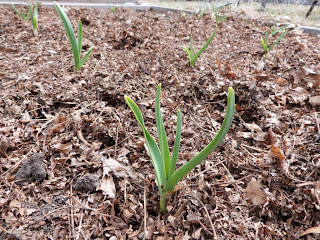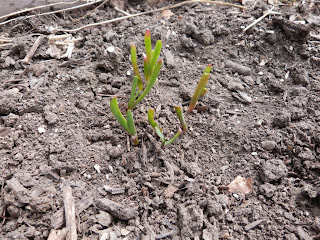Today is Earth Day, which is a good reminder to think about
how all that we do affects the environment. Many of our projects at You Can’t
Eat a Lawn are inspired by a desire to better serve the planet, along with the
benefits to our health and pocketbooks. Eco-consciousness is always in the back
of our minds, but today is a good annual poke to consider ways that we can do
more. For example, it is our goal this year to add rain barrels to our
homestead to conserve more water. But before that little project begins, here’s
a look at some things we’ve already done with some success that anyone can
implement to help the planet.
Compost – Earth Day always features a lot of talk about
recycling, but composting is an often-overlooked companion to also reduce our
amount of trash generation. Think about what you throw away and how much of it
is organic material, or kitchen scraps. Simply piling that material in a bin
with air, water and warmth allows it to break down into wonderful nutrients for
plants without taking up space in a landfill. This is a double win since it
saves you money on buying fertilizers. Even if you don’t have space for an outdoor
compost pile, you can compost indoors with a worm bin.
Plant a garden – Walking through the produce section at the
grocery store is like taking a virtual world tour. Tomatoes from Mexico or
Canada, asparagus from Chile, oranges from Australia. Each one of those items
was trucked, shipped or flown to your store, meaning significant carbon
emissions into our atmosphere. And because it takes so long to travel that
distance, most of this food is picked early and underripe. That’s why a store
tomato cannot compare to the flavor of a fresh garden tomato. If you’re a
novice, start small. How about a window box or small planter? Maybe start with
herbs or greens before graduating to big items like tomatoes and peppers. And
don’t worry about failure. We’ve lost more crops than we can count, but we keep
plugging away.
Buy a share of an animal – We’ve said it before but it bears
repeating that it’s impossible to raise pork chops. The tidy slices of meat you
find at the grocery meat counter were once part of a full animal, including the
less popular parts. For every chop, there is a pork hock, for every chicken
breast, there is a hindquarter. When we buy only the mass-marketed pieces, that
means the other portions are wasted. But there’s a silver lining – some of
those less desirable parts are the most flavorful. You can’t make a decent
split-pea soup without a pork hock, and chicken leg quarters have much tastier
meat than the breasts. Factor in that you’re supporting a local farmer, and it
makes a half hog or beef even better.
Learn to preserve – Canning is largely a fading art,
although it seems to be making a bit of a resurgence. And it’s great for the
planet, too. Suppose you get a bumper crop of a certain fruit/vegetable, and
you’re absolutely inundated, as we’ve found ourselves to be on more than one
occasion. You can try to incorporate that item into every meal, but even that
might not keep up with your harvest. Learning to put that food up, either by
canning or freezing, keeps you from wasting food. And later on, after the
growing season, that preserved food can keep you from needing to buy grocery
store produce from far-flung locations.
We could certainly go on with other ideas that can help you
celebrate Earth Day and become more self-sufficient, but we don’t want to
prattle on for too long. Harvesting rainwater helps protect our waterways and
groundwater; incorporating shredded leaves into the garden loosens the soil
while preserving our peat bogs; planting trees helps capture carbon dioxide,
and if they’re fruit trees, they feed you too. The list goes on and on.
But as we reflect on Earth Day, perhaps the most powerful
tool we can think of is to spread the word about what we, and you our readers,
are doing. Surely each of us knows a person who says gardening is too hard,
takes too much time, or isn’t worth it. Sharing our stories with these
individuals, and the world at large, hopefully might lead to a small change.
From shopping at a grocery store to a farmer’s market. Tearing up a small patch
of grass to grow food. The more small steps like these that we all can
encourage, the more of a change we truly can make for Earth Day, and for every
day.










